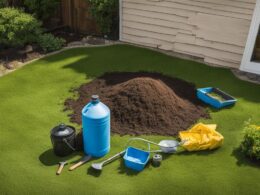If you want your lawn to look beautiful all season long, it’s important to stick to a proper lawn care schedule. This includes using weed control and fertilizer at different stages. One question that often comes up is whether to mow before or after applying weed and feed. In this article, we will discuss the best lawn care tips and provide guidance on how to maintain your lawn with minimal effort.
Before we dive into the ideal order of lawn care, let’s understand the different methods. Weed and feed is a combination of fertilizer and herbicide that improves grass health by eliminating weeds. Herbicides can be selective or non-selective, targeting specific weeds or all vegetation. Pre-emergent weed killers prevent weeds from sprouting. Lawn fertilizer provides nutrients for grass growth.
Different Lawn Care Methods
Before we delve into the ideal order to care for your grass, let’s define each kind of lawn treatment.
Weed and feed is a combination of fertilizer and herbicide that aims to boost the grass’s health and eliminate existing weeds or prevent new weeds from sprouting.
Herbicides, or weed killers, can be selective or non-selective, and they target specific weeds or may kill all vegetation.
Pre-emergent weed killers prevent weeds from sprouting by creating a chemical barrier on the soil’s surface.
Lawn fertilizer comes in granules or liquid form, providing nutrients to the soil for grass growth.
Now that we have a better understanding of the different lawn care methods, let’s explore the optimal order to care for your grass to achieve a healthy and thriving lawn.
Whether to Apply Weed and Feed Before or After Mowing?
One of the common questions that arises in lawn care conversations is whether to apply weed and feed before or after mowing. The timing of this process plays a significant role in optimizing its effectiveness and ensuring a healthy lawn.
It is generally advised to apply weed and feed before mowing for better results. This is because weeds have a larger foliage surface area to absorb the herbicide when they are actively growing. Applying weed and feed before mowing allows the herbicide to target the weeds more efficiently, as they can absorb it through their leaves.
After applying weed and feed, mowing your lawn helps to reduce the surface area of weed leaves and temporarily halt their growth. It also helps ensure that the herbicide penetrates the grass effectively, reaching the weed roots and preventing their regrowth.
For optimal timing, it is recommended to apply weed and feed two days before mowing. This allows the herbicide to penetrate the grass, starting its work on the weeds, and gives the product enough time to take effect. However, it’s essential to consider that different weed and feed products may have specific instructions for the ideal mowing times. Therefore, it’s crucial to read and follow the instructions provided by the specific product you are using.
Maintaining a regular mowing schedule and applying weed and feed at the right time not only helps control weeds but also promotes the overall health and appearance of your lawn. By following these guidelines, you can achieve a lush and vibrant lawn throughout the season.
Guidelines for Different Grass Types and Environments
The effectiveness of weed and feed may vary depending on the type of grass and the climate zone. If you have cool-season grasses, which are commonly found in regions with significant temperature changes like the Midwest and East Coast, the best time to treat them with weed and feed is in spring and autumn. On the other hand, if you have warm-season grasses, which are common in the Southern United States, you should apply weed and feed in the early spring.
To ensure optimal lawn care, it’s essential to use the right formulations of weed and feed for your grass type and climate zone. Different products are available, such as cool-season formulations for grasses in colder regions and southern formulations for grasses in the South. Be sure to carefully follow the instructions provided by the specific product you are using to achieve the best results.
Image: Grass types and climate zones
Which Comes First: Weed Killer or Mowing?
The timing of using weed killer before or after mowing depends on the type of weed killer being used. Pre-emergent weed killers should be applied before mowing, typically in late autumn or winter, to prevent weed seeds from sprouting. This ensures that the weed killer forms a protective barrier on the soil, effectively stopping weed growth before it even begins. By applying pre-emergent weed killer before mowing, you can eliminate weed seeds and reduce the overall number of weeds in your lawn.
On the other hand, post-emergent weed killers are applied to actively growing weeds. These weed killers target and kill existing weeds in your lawn. The timing of mowing in relation to post-emergent weed killer application depends on the specific product’s instructions. Some post-emergent weed killers may require mowing before application to ensure that the entire weed is exposed to the herbicide. Others may recommend mowing after applying the weed killer to remove the dead weeds and improve the appearance of your lawn.
When using pre-emergent or post-emergent weed killers, it is important to follow the recommended mowing guidelines provided by the product manufacturer. These guidelines may vary depending on the type of weed killer and the specific weeds you are targeting. By following these instructions, you can ensure that the weed killer is applied at the right time and in the most effective manner.
Mowing Before or After Fertilizing?
When it comes to maintaining a healthy lawn, understanding the proper sequence of lawn care tasks is essential. One common question that arises is whether to mow the grass before or after fertilizing. So, what is the best approach?
Experts recommend mowing the grass before applying fertilizer. This ensures that the nutrients in the fertilizer are evenly distributed and penetrate the soil effectively, resulting in optimal lawn health. By mowing first, you create a clean, even surface that allows the fertilizer to reach the grass roots more efficiently.
If you’re wondering about the ideal schedule, consider mowing the grass one day and fertilizing the next. This allows for a steady cycle of lawn care maintenance and helps keep your lawn looking its best. Remember to water the lawn after fertilization, but be cautious not to overwater. Overwatering can dilute the nutrients and cause them to run off, reducing the effectiveness of the fertilization process.
Fertilizing your lawn according to a schedule is crucial for maintaining its health and appearance. Following the recommended guidelines for mowing before fertilizing ensures that your lawn receives the necessary nutrients at the right time, promoting lush growth and vibrant color.
In conclusion, mowing before fertilizing is the preferred approach for lawn care. By following this sequence and adhering to a fertilizing schedule, you can effectively nurture your lawn and achieve the lush, healthy landscape you desire.
Should You Mow Your Lawn Before Applying Weed and Feed?
When considering lawn care tips for mowing, it’s best to mow your lawn before applying weed and feed. This allows the fertilizer to reach the soil more effectively, promoting healthy growth while also minimizing weed growth. Mowing first ensures the product can penetrate the grass for optimal results.
Conclusion
Taking care of your lawn involves various factors, including mowing, weed control, and fertilization. By following the proper timing and guidelines for mowing before or after weed and feed application, as well as fertilizing, you can ensure the optimal health and appearance of your lawn. Remember to consider the specific needs of your grass type and climate zone when choosing the right lawn care products. Regular maintenance and adherence to a lawn care schedule will help keep your grass thriving throughout the season.
To summarize, here are the best practices for lawn care:
- Mow before applying weed and feed to allow better absorption and reduce weed growth
- Choose the appropriate weed and feed formulations for your grass type and climate zone
- Apply pre-emergent weed killers before mowing to prevent weed seeds from sprouting
- Apply post-emergent weed killers according to specific product instructions
- Mow before fertilizing to evenly distribute nutrients
- Water the lawn after fertilization, avoiding overwatering
- Follow a regular lawn care schedule to maintain the health of your grass
By implementing these practices, you can achieve a beautiful and thriving lawn that enhances the overall appeal of your outdoor space.










